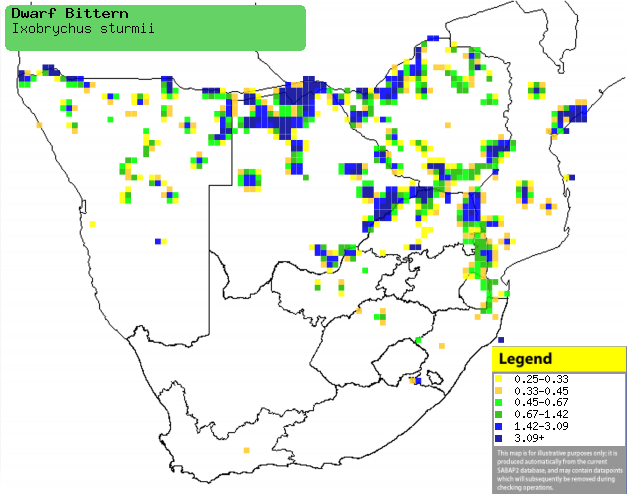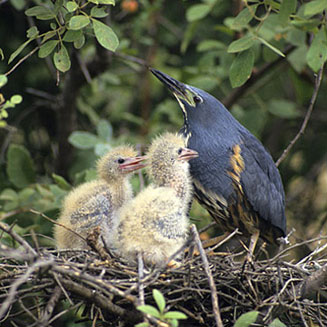|
Ixobrychus sturmii (Dwarf
bittern)
Dwergrietreier [Afrikaans]; Hakaruu (generic term for
short-necked herons and bitterns) [Kwangali]; Afrikaans woudaapje [Dutch];
Blongios de sturm [French]; Sturms zwergrohrdommel [German];
Garçote-anão [Portuguese]
Life
> Eukaryotes >
Opisthokonta
> Metazoa (animals) >
Bilateria >
Deuterostomia > Chordata >
Craniata > Vertebrata (vertebrates) > Gnathostomata (jawed
vertebrates) > Teleostomi (teleost fish) > Osteichthyes (bony fish) > Class:
Sarcopterygii (lobe-finned
fish) > Stegocephalia (terrestrial
vertebrates) > Tetrapoda
(four-legged vertebrates) > Reptiliomorpha > Amniota >
Reptilia (reptiles) >
Romeriida > Diapsida > Archosauromorpha > Archosauria >
Dinosauria
(dinosaurs) > Saurischia > Theropoda (bipedal predatory dinosaurs) >
Coelurosauria > Maniraptora > Aves
(birds) > Order: Ciconiiformes
> Family: Ardeidae
Distribution and habitat
Occurs across sub-Saharan Africa; in southern Africa, it is
generally uncommon in northern Namibia, northern and south-eastern Botswana, Zimbabwe,
central and southern Mozambique and north-eastern South Africa. It generally
prefers seasonally flooded plains with scattered trees and bushes, marshes,
temporary pans, flooded grassland and occasionally mangroves.
|
 |
|
Distribution of Dwarf bittern in southern Africa,
based on statistical smoothing of the records from first SA Bird Atlas
Project (©
Animal Demography unit, University of
Cape Town; smoothing by Birgit Erni and Francesca Little). Colours range
from dark blue (most common) through to yellow (least common).
See here for the latest distribution
from the SABAP2. |
Movements and migrations
Intra-African breeding migrant, arriving in
southern Africa in the period from October-December to breed. It usually stays
until March or April, at which point it heads north to its
non-breeding grounds in equatorial Africa.
Food
It mainly eats fish, frogs and aquatic insects, doing most
of its foraging at dusk and at night, wading through shallow water in search of
small animals. It also perches
on a tuft of grass, stabbing prey that passes by. The following food items have been recorded
in its diet:
- Vertebrates
- Invertebrates
- water-bugs
- crabs and other crustaceans
-
spiders
Breeding
- Monogamous and usually a solitary nester, although nests may be closed
closely spaced in prime habitat, such as Nylsvley, Limpopo Province.
- The nest (see image below) is built opportunistically by both sexes in
1-2 days, consisting of a flimsy platform of twigs and coarse grass stems,
typically placed in a thorny bush or tree flooded by water.
 |
|
|
Dwarf bittern at its nest with chicks, Nylsvley area, South Africa.
[photo
Warwick Tarboton ©] |
|
- Egg-laying season is from November-April, peaking from January-February.
- It lays 2-5 eggs, which are incubated by both sexes for about 18-26
days.
- The chicks are fed by both parents, first exploring the area around the
nest after a week, leaving the nest permanently at about 12-13 days old.
Threats
Not threatened.
References
-
Hockey PAR, Dean WRJ and Ryan PG 2005. Roberts
- Birds of southern Africa, VIIth ed. The Trustees of the John Voelcker
Bird Book Fund, Cape Town.
|
